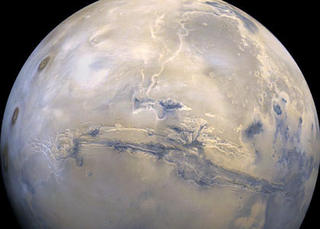What Caused the Martian Floods?
 from ScienceNOW, Science Magazine's online news
from ScienceNOW, Science Magazine's online newsThe surface of Mars sports deep channels, apparently gouged by huge deluges. The source of this water remains a mystery, however. Now researchers suggest that kilometer-thick mineral deposits, which trapped water in the planet's early years, suddenly released their bounty when warmed by heat from the planet's interior.
In the 1970s, orbiters first spotted Mars' extensive channels; some of the deepest extend from the mouth of Valles Marineris, the biggest canyon in the solar system at 4000-kilometers-long. One leading explanation for the channels is that thick layers of ice trapped groundwater, and the water burst forth when the ice cracked. But many experts doubt that enough water could have built up, or that it could have shot out fast enough to dig the channels.
Now a study suggests a new mechanism for rapid flooding. Geomorphologist David Montgomery and geologist Alan Gillespie of the University of Washington, Seattle, studied more detailed images of the Valles Marineris area recently taken by the Mars Orbiter Camera and Mars Orbiter Laser Altimeter. They then tied the data together with past observations of thick sulfate deposits.
Montgomery and Gillespie postulate that during an early, wet period in Mars' history, the sulfate was deposited on lakeshores, trapping water in the minerals. Lava flows later buried the sulfate layers. Covered by this rocky insulation, the sulfates were warmed by the heat from the planet's interior, the group reports in the August issue of Geology. The sulfates then shed their water, which built up under the cooled lava, creating a kilometer-high bulge. Finally, the bulge burst open, collapsing in the middle, and let loose floodwaters that scoured out a canyon and the nearby channels.
"This is exactly what we see [in the satellite data]: a giant blister with a crack down the middle," Gillespie says. Smaller sulfate deposits elsewhere may be responsible for other channels, he says.
This study "may have provided a solution" to the questions raised by other flood theories, says planetary geoscientist Lionel Wilson of Lancaster University in the U.K. Others are skeptical. "Everything is plausible" in this model, says geologist Gian Gabriele Ori of the International Research School of Planetary Studies in Italy. But he thinks the sulfates inside Valles Marineris were deposited after the canyon formed, and so could not have created the canyon. A new orbiter will start taking pictures next year that could resolve the age of the deposits.
--MHI
Related sites
More about Mars, from the U.K. Natural History Museum
USGS page on Valles Marineris
NASA's Mars Orbiter Laser Altimeter (MOLA)













0 Comments:
Post a Comment
<< Home